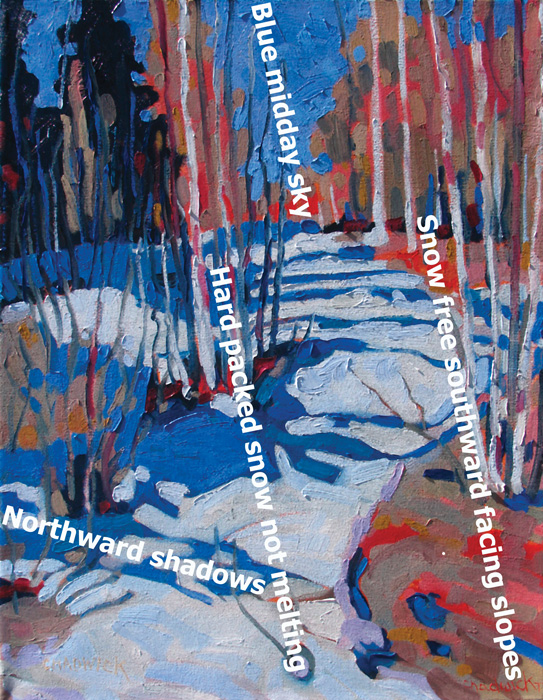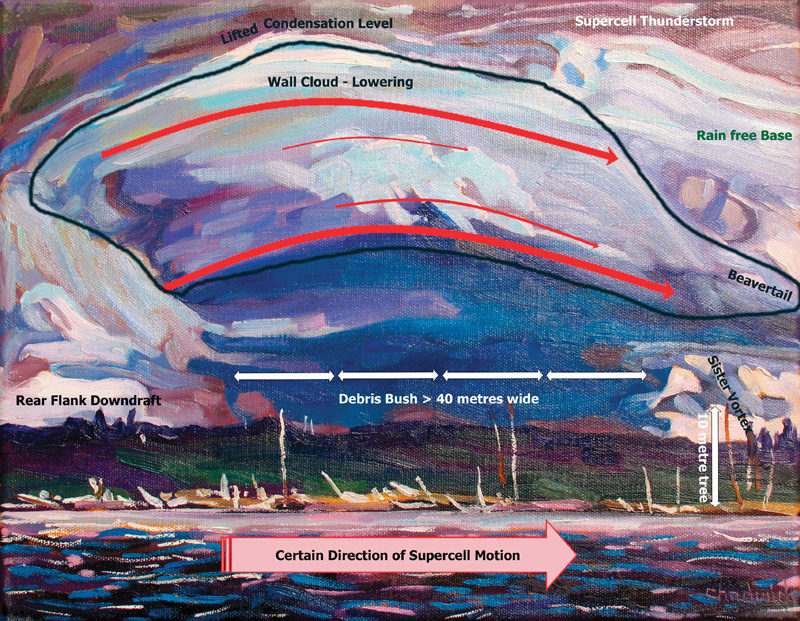[Winter 2013]
by Bénédicte Ramade
Meteorology is a science of prediction. Every day, 2.5 quintillion bytes of information are analyzed in order to anticipate precipitation, predict temperatures, and so on.1 The weather report, on tv or radio, has become an indispensable barometer, and there are now countless weather “aps” available. Forensic meteorology, on the other hand, involves analysis and reconstruction of the climatic conditions at the time a crime was committed in order to confirm or impeach its chronology. Phil Chadwick, a meteorologist with Environment Canada and landscape painter who works in Algonquin Park, has for a number of years been applying forensic meteorology analysis and interpretation to the paintings of the Group of Seven and its precursor, Tom Thomson. But he is not solving any crime; his interpretations are of a different order.
During his public lectures, Chadwick “elucidates” some of Thomson’s most famous studies, making extensive use of animation, arrows, directions, and complex scientific explanations to attest to the meteorological accuracy of the climatic effects depicted in the 1910s. His analysis of Thomson’s famous Thunderhead, painted in 1913 (National Gallery of Canada, Ottawa), indicates, for example, that the title of the panel is actually misleading; Tornado would be more appropriate if we are to believe his demonstration of the classic development of an F2 (on the Fujita scale) tornado. Using a series of diagrams and arrows indicating the direction of movement of the low-pressure supercell (from left to right, or west to east) and calculating distance travelled according to the size of the trees, Chadwick tells us that Thomson would have been facing north and close enough to portray accurately the destructive trajectory of the tornado that swept through less than two hours later. Beyond this correction made to the subject of the painting, Chadwick sets out to demonstrate that Thomson was a fine observer of nature and a meteorologist. “Tom Thomson was a weatherman” is his conclusion regarding the painter, up to now acknowledged for having captured “the soul of Canada”2 – a more mystical interpretation that does not hold up well in the light of forensic meteorology.
Chadwick sets aside the aesthetic dimension of Thomson’s works, as well as their art-historical, artistic, and social contexts, in favour of a different, scientific gaze guided by an imperative of meteorological veracity that takes no account of the painter’s great renown. Isolating a single variable, he redefines each of his “cases” according to meteorological data, forcefully activates details to transform the works into evidence based on the permanence of certain climatic phenomena. For instance, the 1915 painting Clouds (“The Zeppelins”) (National Gallery of Canada, Ottawa) faithfully depicts the formation of a warm front, with its cohort of cirrus clouds. This time, Thomson was set up in a low-pressure zone and looking southward, as Chadwick, obsessed with his search for the truth, informs us. Elements from the position of the stars to the appearance of the cloud formations in the sky form the arsenal for what Chadwick has called, not without irony, csi, or “Creative Scene Investigation,” a wordplay on the titles of a group of successful TV crime-show series. csi is the hallmark of Chadwick’s public demonstrations of his science, during which he counts out the seasons with the help of paintings by Thomson and members of the Group of Seven.3 The high period of Canadian art, revisited in the light of forensic meteorology, is enriched by a veristic dimension and thus gains climatic dna.
This realistic interpretation of Thomson’s art is part of a movement to authenticate the masterpieces of art history – a movement to which University of Texas astronomer Donald Olson subscribes. Olson has used forensic astronomy to demonstrate the veracity of the celestial configurations depicted by Edvard Munch in The Girls on the Bridge (1899) and The Scream (1893). Caustically compared by Sue Prideaux, a Munch expert, to a “crossword addict,”4 Olson has tools and intentions analogous to Chadwick’s. Unary interpretation of artworks in the light of forensics – astronomic or meteorological – disrupts our aesthetic norms and challenges the acceptability of such a method in the field of art history in the name of a rather subversive logic of authenticity. Paintings would thus become evidence of realism even though the demonstration doesn’t invalidate their aesthetic and cultural probity. “It still has the same emotional impact, we are just separating the real from the unreal,” notes Olson in response to criticism of his project.5
Although we know about forensic verifications and authentications in litigious cases of dating (for instance, Olson has determined the day and time when Ansel Adams took the photograph Autumn Moon) and attribution (the expert Paul Biro analyzed the paint on a painting made “Pollock style,” found by a septuagenarian in a flea market, in a salty saga filmed by Harry Moses in 2006, Who the Fuck is Jackson Pollock?), forensics now offers a new application. Certainly puzzling because the aesthetic aspect of the artworks is never really challenged, this new perspective, in Chadwick’s case, makes Thomson into a naturalist whose studies are strict, faithful recordings of climatic phenomena. Chadwick’s and Olson’s scientific undertakings thus jeopardize the romantic mythology and folklore surrounding a number of masterpieces, but also reduce the field to an iconographic issue. In the strict sense, the true Canadian identity of landscapes by Thomson and the Group of Seven cannot be in doubt when analyzed through the forensic lens. Tom Thomson is therefore found guilty of being a meteorologist.
Translated by Käthe Roth
2 See John O’Brian and Peter White, “Introduction,” in John O’Brian and Peter White (eds.), Beyond Wilderness: The Group of Seven, Canadian Identity, and Contemporary Art (Montreal and Kingston: McGill-Queen’s University Press, 2007), p. 4: “The artists and their supporters argued that national identity was inseparable from the geography and climate of Canada’s boreal land mass.”
3 Chadwick has analyzed two hundred paintings to date.
4 Quoted in Jennifer Drapkin and Sarah Zielinski, “Forensic Astronomer Solves Fine Arts Puzzles,” Smithsonian Magazine, April 2009, www.smithsonian mag.com/arts-culture/Celestial-Sleuth.html.
5 Ibid.
Trained as a nuclear physicist, Phil Chadwick found a career in meteorology with Environment Canada in 1976. He specializes in severe weather conditions. Aside from his work as a meteorologist, he is also a recognized artist with a passion for painting the natural world. His artworks are depictions of personal experiences. They hang in many private and corporate collections around the globe. Several magazines and calendars have used his work. Over the years Chadwick has brought together his knowledge of weather phenomena and his eye for artwork in a speaker series on an area of research that he calls forensic meteorology to deduce the time, orientation, and weather surrounding events captured in the works by Canadian artists Tom Thomson and all members of the Group of Seven, who were particularly accurate observers of the natural world.
Bénédicte Ramade is an art historian. Currently, she is completing her doctorate on the topic of the critical rehabilitation of American ecological art. As a journalist and art critic, she has developed expertise on issues of nature and ecology in contemporary practices, which she puts to use as an exhibition curator: Acclimatation, Villa Arson, Nice (2008–09); REHAB, L’art de re-faire, Fondation EDF, Paris (2010–11).



